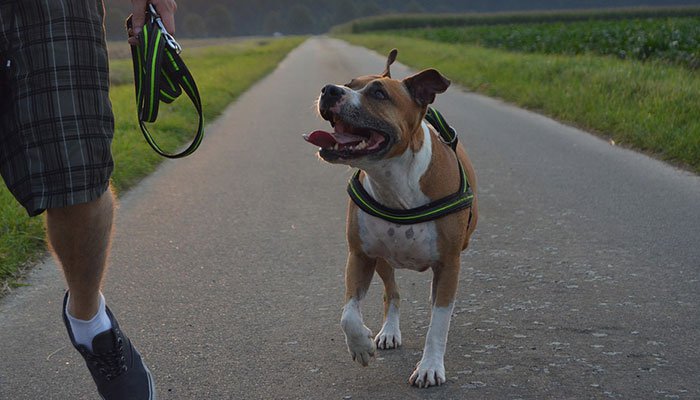Chocolate Lab: The Delicious Scoop
Table of Contents
Anything with the word chocolate added to it must be a winner! Am I right? Chocolate labs are the epitome of a winning dog! They are intelligent, loyal, friendly, and easily trainable! What more could you want in a dog?
The chocolate lab is not its breed. It is a type of Labrador retriever (more on those below). Chocolate refers to its fur color, which is a rich shade of brown.
Are you still on the fence about purchasing a chocolate lab? Then this article is exactly what you need to help you make your final decision!
What is a Chocolate Lab?

Chocolate labs are one of the many color variations of the Labrador retriever. While a chocolate lab isn’t a specific breed, it is a very sought-after type of dog. They are one of the most popular companion dogs in the United States.
A labrador retriever is a type of working dog that has been bred throughout the years to be a gentle companion dog breed. They have an immense amount of loyalty for their owners and are typically friendly with everyone, although they are sometimes known to have anxiety with strangers. Labs are outgoing, loving, as well as lovable.
The chocolate lab can be called a liver lab, a brown lab, or a chocolate Labrador retriever.
Where Did the Chocolate Lab Originate From?
The chocolate lab is thought to have been originally bred in Northern Canada in Newfoundland. Not to be confused with a much larger dog breed known as the Newfoundland or Newfie, which is also from Newfoundland.
What Was the Chocolate Lab Bred for?
Chocolate labs were bred to be working dogs for fishermen and hunters to help retrieve their prey, haul in fishing nets, and help recover lost items. Chocolate labs have a gentle bite and are easily trainable which is the ideal temperament for a working dog.
Chocolate labs have excellent diving skills and swimming abilities, they can recover items in the water with ease. Breeders and owners loved that this breed was so easily trainable, and had incredible loyalty to their owners.
What Does A Chocolate Lab Look Like?

The chocolate lab is covered in short, dense fur that is a deep shade of brown. Their rich coloring comes from a gene called eumelanin, depending on the amount of eumelanin the dog has, its color can be chocolate, yellow, or black. Chocolate labs have a medium amount, which makes them brown. Black labs have a lot of eumelanin, while yellow labs have none.
Chocolate labs have a thick double coat of short fur that is both insulating and moisture-repellent. Their fur helps to block their skin from sunlight, as well as other contaminants such as dirt, dust, and debris.
Chocolate labs should have a balanced physique that is lean and muscular. They should not be round in their core. While you may see many portly chocolate labs, this is not an ideal body shape. Round labs are overweight, which can lead to illness, disease, and a reduced lifespan.
Unique Physical Characteristics
Eyes
Chocolate labs have round, wide-set eyes that are big and beautiful! Their eyes range in color from dark brown to a light shade of hazel.
Tail
A chocolate lab has a thin tail that is neither long nor short. Their average-length tail is straight and covered in short brown fur, it assists them while swimming by helping them turn.
Ears
Chocolate labs have L-shaped ears that are medium-sized and floppy! Their ears are covered in short fur that should be groomed regularly.
Snout
Chocolate labs have a pointed muzzle that is typically long and narrow. Their slender snouts are good for hunting and retrieving.
How Big Does a Full-Grown Chocolate Lab Get?

The chocolate lab is the same size as other lab colors. They can be as tall as 24 inches and as short as 21 inches, and they weigh between 55 and 80 pounds as adults.
Male vs Female
Males often weigh more than females, there is around a 5 to 10-pound weight difference between the two. Males and females are more likely to be of similar height though.
Different Types of Chocolate Lab
English Chocolate Lab
English chocolate labs are a bit bulkier and have a wider head than American labs. These dogs have wide chests and thick necks which give them a solid appearance. They also have shorter stature. English labs are laid back and adapt easier to a slow-paced lifestyle.
American Chocolate Lab
The American chocolate lab is slimmer and has a more athletic physique. They are agile, lean, and have longer legs than English chocolate labs. American labs have thinner fur as well. These dogs have a higher energy level and need more stimulation, they adapt well to high-energy homes.
How to Take Care of a Chocolate Lab?
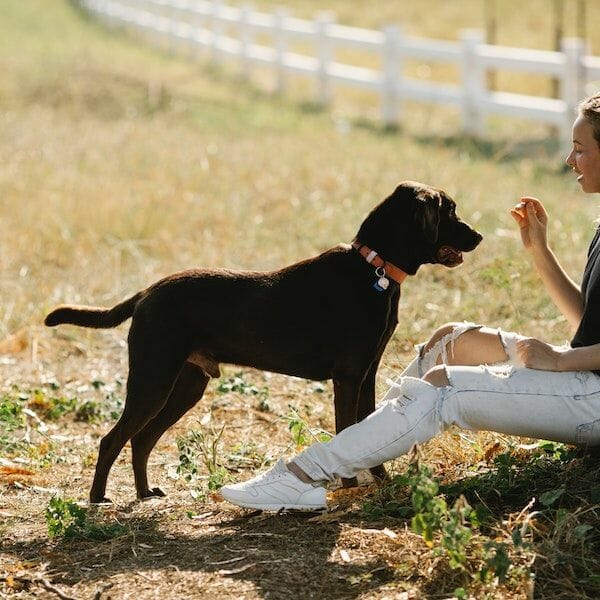
Chocolate labs are not a hard breed of dog to care for and raise. They are one of the easier breeds to bring into adulthood. Below we will discuss your chocolate labs exercise, grooming, and dietary needs.
Exercise
Labs need both mental and physical exercise to help keep their minds and bodies healthy. They require tasks that make them think, but they need physical stimulation as well.
Physical exercise is very important for a chocolate lab, exercise helps keep them agile and fit. They will need to exercise every day for at least an hour, up to two hours for younger dogs with an abundance of energy. Physical exercise helps keep your chocolate lab at a safe and healthy weight.
Chocolate labs excel in many types of exercise, they love going swimming, playing fetch, and taking briskly paced walks. On the days that you are unable to exercise your dog, it is best to allow them to roam freely in a fenced-in backyard. You could also opt to take them to a local dog park to help them release their energy while still playing by the rules with your guidance.
Chocolate labs can become destructive when they are not given enough exercise each day. You should allow your lab to deplete all of its energy to keep them from chewing, scratching, or becoming destructive.
Grooming
Grooming your chocolate lab on a regular schedule helps keep them smelling fresh and looking good! Grooming is also beneficial for their health! It’s better to know how to calm them while being groomed.
Chocolate Labs have a dense coat that is made up of two layers, which means they can shed a lot! To help reduce the amount of hair released, brush your chocolate labs a few times per week! Brushing your lab also helps its coat by redistributing its oils throughout the fur.
Another way to help your lab’s fur stay fresh and clean is to bathe them every few weeks. Bathing your lab with quality-made shampoo will help their skin and allow their fur to stay healthy. Clean fur also can help reduce allergies.
Your lab ears should be cleaned regularly and always kept dry. Due to the L shape, the ears must dry to avoid excess moisture from gathering inside. Their inner ear can become infected if it is left wet, which can cause many ear complications.
Your chocolate lab will also require its nails to be cut and trimmed every few weeks, as well as brushing its teeth and cleaning its eyes.
Diet
The diet of your chocolate lab should be high in protein with a smaller amount of carbs and fat. Their food should be made with premium quality ingredients. Always discuss your dog’s dietary needs with your veterinarian. They will help you find the best dog food option for your dog!
How Much to Feed
Your chocolate lab will love to eat! But be sure to carefully measure out their food, and only serve them what is required. Labs gain weight rather quickly when they are left to eat freely throughout the day, so always be sure to give them 3 to 4 cups of food per day.
Overfeeding your chocolate lab will cause them to be overweight or obese. Extra weight around your dog’s midsection can increase its chances for other illnesses or diseases. Extra weight also decreases their quality of life.
How Often to Feed
Your chocolate lab will be ready to eat at any time of the day, but they should have a set feeding schedule that provides at least 2 meals per day. We suggest three meals per day, especially for high-energy dogs. Aim to feed your lab three small meals per day, once in the morning, afternoon, and evening.
Common Food Allergies
Chocolate labs are allergy sufferers, especially food allergies. Many labs are allergic to the protein found in meat, dairy, and eggs. They can also be allergic to common dog food ingredients such as corn, soy, and wheat. Other allergens include preservatives, food dyes, artificial flavors, or any other added ingredients or supplements.
The symptoms of food allergies can range from mild to severe. Mild symptoms include itchiness around the skin or eyes, hives, or coughing.
Severe symptoms of an allergic reaction can be swelling of the hands, feet, or face, vomiting, wheezing, or anaphylaxis which can lead to death.
If you suspect that your dog is suffering from an allergic reaction to something in its food contact your vet as quickly as you can. Even mild cases of allergies can get worse over time. Your vet will work with you on ways to help your dog recover, and even pinpoint which ingredients are causing the allergic reaction.
Are Chocolate Labs Easy to Train?
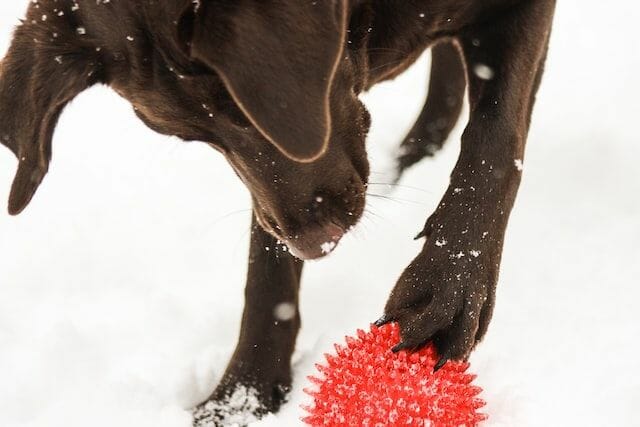
Chocolate labs are an incredibly intelligent type of dog, they are easy to train and eager to please their trainers. Labs are great therapy dogs, and with their instinct to please they are capable of many things. Many chocolate labs assist with daily tasks such as retrieving the mail, opening and closing doors and turning on the lights.
Are they Easy to Potty Train?
Potting training comes very easily for the chocolate lab, but it is best to introduce this task as early on as possible. Young labs may show some resistance at first, but they are eager to please their owners and will quickly catch on.
What is the Chocolate Lab’s Temperament?

Chocolate labs have a wonderful personality that is both fun and friendly. They make great companion pets, but can be very high-energy during their first few years. Allowing your chocolate lab enough daily exercise can help reduce their energy levels and help them become calm.
They love people, especially their owners and family.
Some chocolate labs may experience anxiety around strangers or new faces, they may howl or growl at the unexpected person. Anxious behavior can be helped with proper training, positive reassurance, and socialization.
Does This Breed Do Well With Children?
A chocolate lab is a true family dog, they are great with young and old children. They are gentle, friendly, and patient with kids, which makes them a top choice for a household pet.
Before you leave any dog, even a chocolate lab, with your children, always be sure the children are well-behaved. Teach your children how to properly pet a dog and how to care for them. Never promote any behavior that could scare or upset the dog. A scared dog can become a dangerous dog.
Don’t allow any children around a dog that shows aggression or anxious behavior toward them.
Does This Breed Do Well With Other Pets?
Chocolate labs are typically great with homes that already have a full house of pets! They are dog and cat-friendly, playful, and gentle with other pets. They are not an aggressive breed, but early socialization is best when you want to add to the pack.
Are Chocolate Labs Aggressive?
Chocolate labs are not an aggressive dog breed, they are friendly and gentle dogs.
Always be aware of all dogs though, any dog has the chance to become aggressive especially if they feel threatened, afraid, or anxious. Pain and illness can also cause your dog to act unexpectedly aggressive.
What Environment is Ideal for a Chocolate Lab?

Chocolate labs can thrive in most environments. While they do have an abundance of energy while they are young, the chocolate lab can be trained to thrive in most places. They adapt well to family life and love people who can match their energy level.
Labs are not a fan of being left alone, they do best with an owner who stays home. When a chocolate lab is left alone too often, they can become bored, especially if they haven’t exercised enough. They express their boredom and loneliness by becoming destructive. They may chew furniture, mark their territory, or scratch floors, walls, and doors.
City vs Rural
Chocolate labs love to exercise! They thrive with owners who have large properties with a backyard. Fenced-in backyards are the ideal place for them to run and release energy.
Chocolate labs are also very adaptable and trainable, which means they can live in small places as long as they have an outlet for their energy and are taken on walks. Dog parks are also very helpful when looking for a place to exercise your dog if you live in a city.
Cold or Hot
The chocolate lab has a double layer of fur that helps regulate its body temperature in the winter. They can tolerate cold weather better than a dog with only a single coat. But, they should not be left in below-freezing weather for too long or unsupervised.
Summer months should be handled with care, all dogs can have a heat stroke. Always provide your lab with a shady spot to lay while out in the sun, and provide them with plenty of water. Be aware of the symptoms of a heat stroke and monitor your dog at all times when it is hot outside.
What is the Average Lifespan of a Chocolate Lab?
When a chocolate lab is properly exercised, fed a good diet, and cared for, it can live between 11 and 13 years.
Chocolate Lab Common Health Issues

Chocolate labs are less likely to suffer from extensive health issues compared to other breeds. Breeders are using quality dogs which have made this breed generally healthier than others. But, even the best bloodlines can have health problems such as allergies, glaucoma, hip dysplasia, or diabetes.
Allergies
Dogs can often suffer from various types of allergies. Allergies are symptomatic when the body reacts to various stimuli. The immune system of the dog reacts to the stimuli which create a reaction such as itching, swelling, redness, coughing, vomiting, diarrhea, or anaphylaxis.
Dogs can suffer from one type of allergy, or have a combination of multiple. Food allergies, skin allergies, and environmental allergies can all create symptoms.
Skin allergies can be triggered by bug bites from ticks or fleas. They can also manifest from food or environmental allergens. Hives, itchy skin, redness, and swelling are all symptoms of skin allergies.
Food allergies are triggered by various ingredients that your dog may consume. Dogs can be allergic to anything, even chicken, eggs, dairy, wheat, corn, or soy.
Environmental allergies are triggered by anything in their environment that can trigger an allergic reaction. Pollution, mold, and dander can all be considered environmental allergies.
Glaucoma
Chocolate labs can develop an eye disease known as glaucoma, this disease is caused by an increase in pressure in the eye. Glaucoma can lead to other eye disorders and blindness.
Hip Dysplasia
Hip Dysplasia is a common disease that causes a deformity in the hip. When the puppy grows too fast, its hip bone and socket may not grow in sync with each other creating unevenness in the hip and looseness in the hip joint.
An improperly aligned hip can cause pain, discomfort, or balance issues. It can also lead to other problems such as osteoarthritis, degenerative joint disease, or immobility.
Diabetes
Dog diabetes is a metabolic disorder that causes glucose and insulin levels to act up. Diabetes can manifest as excessive thirst, frequent urination, weight loss, and increased hunger. There are many dangers that come along with diabetes, and the threat of death is very serious. Your dog is also at risk of seizures, cataracts, and kidney failure.
Obesity
Obesity occurs when there is an accumulation of too much fat on your dog’s body. Being overweight often leads to being obese, obesity has its challenges such as mobility, breathing, and staying healthy overall. Obesity often leads to early death.
To help your dog stay slim it is important that you allow them to get enough daily exercise. Exercise is great for your dog’s metabolism and overall health. Never allow your chocolate lab to eat freely whenever they want. This creates a habit called grazing which can cause weight gain.
How Much Does a Chocolate Lab Cost?

Chocolate labs typically cost around $1,000 but can cost upwards of $1,500 depending on the breeder and location. Shelters sometimes have chocolate labs available for adoption, these dogs will cost around $300, and will already have their shots, dewormer, and will have been spayed or neutered.
Other Costs
The adoption fee is not the only cost that comes along with bunching a chocolate lab. Your new puppy will need many new things to live a happy and healthy life with you, and you are responsible for buying what they need. Dogs need food, treats, bowls, toys, bedding, leashes, and collars! These items can easily add up to $200 or more.
Your puppy will need yearly checkups at their veterinarian, and don’t forget to factor in emergency vet visits for unexpected illnesses or accidents! These vet appointments can cost between $200 and $1,000 each!
The cost to own a dog goes way beyond the initial investment, it is a monthly balance that must be factored into your budget!
Other Similar Dog Breeds
Golden Retriever

Golden retrievers have a very similar temperament to a chocolate lab, which makes that the perfect alternative. Both breeds are loving, loyal, and affectionate. Goldens are great dogs for families with children or other pets. They are easily trainable and obedient, with a soft demeanor. Golden retrievers are large dogs that can weigh up to 75 pounds. A healthy golden can live between 11 and 13 years.
Newfoundland
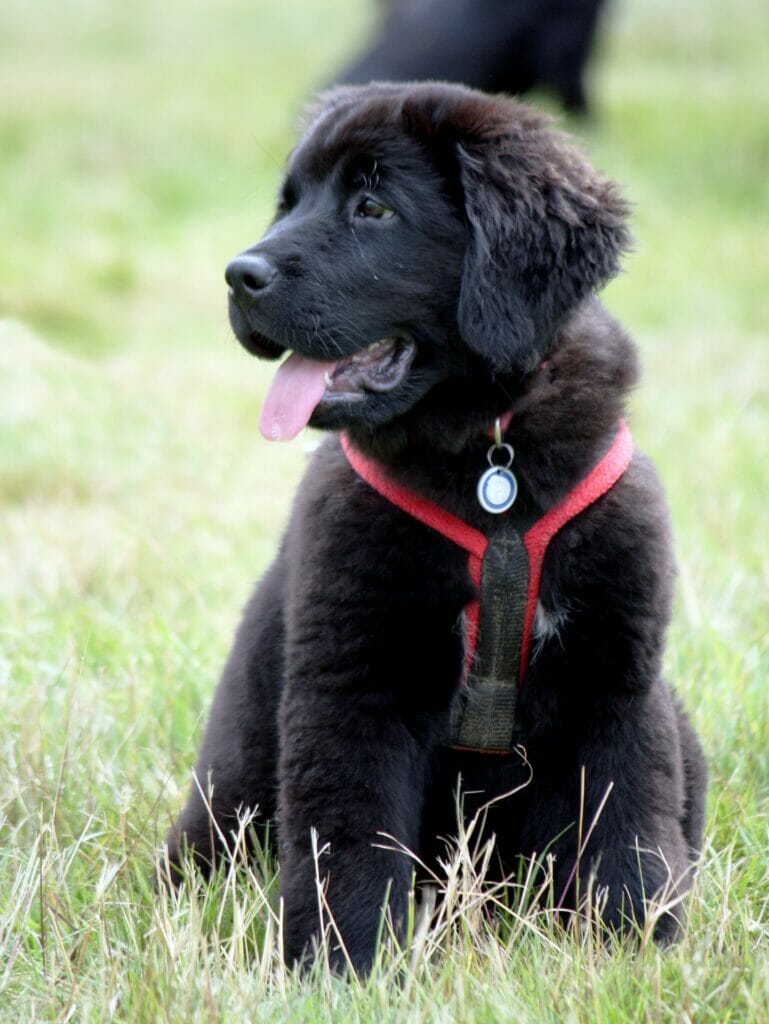
Newfies are giant teddy bears! These dogs are fun to cuddle with and make great pets for people with large families. They are kid and pet friendly, with lots of love to give! If you want a giant dog that is similar to a chocolate lab, then a Newfie may be a great alternative! Newfies and labs both come from Newfoundland, Canada. These dogs can weigh as much as 150 pounds and live on average for 10 years.
Newfoundland Lab Mix (Newfidor)

Check out a Newfie mixed with a Labrador retriever as well! These dogs are similar to a Newfie, with all the perks of a lab! They are also loving, gentle, and full of personality! While many newfidors are smaller than a Newfie, they can grow to be just as big as their 150-pound parent!
Golden Retriever Lab Mix (Goldador)

The Golden retriever lab mix is one of the best alternatives to a chocolate lab. This lab mix is very even-tempered and loving, with just as much cuteness as a chocolate lab! The goldador is full of energy and responds well to children, pets, and strangers. They are perfect for first-time dog owners and make a great companion pet. They weigh around 70 pounds and can live between 12 to 14 years!
Border Collie Lab Mix (Borador)

The Borador is a fun and exciting dog breed with an abundance of energy and love to give! The Borador is a cross between a border collie and a Labrador retriever, they are a medium-sized dog that typically weighs around 50 to 60 pounds. They are a playful dog breed that is great for high-energy families.
German Shepherd Lab Mix (Sheprador)
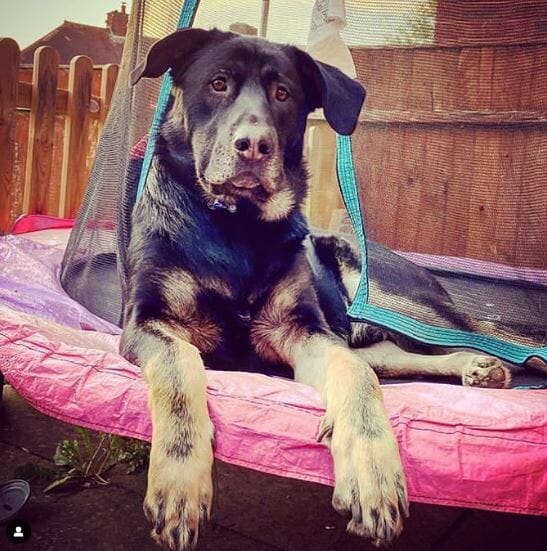
The Sheprador is a hybrid mixture of a German Shepherd and a Labrador retriever. Shepradors are intelligent, protective, and easily trainable. They can be a little stubborn at times, and require an owner with a little bit of experience. These dogs are loving and loyal and are great companion pets. The Sheprador can weigh up to 85 pounds and live to be about 12 years old.
Tips For Finding The Right Breeder
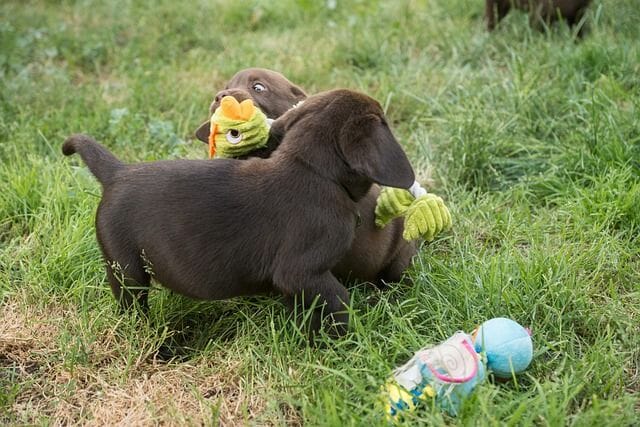
Talk To People You Know
Puppy shopping can be fun, exciting, and stressful! Not knowing where to start with your journey can be frustrating and scary. You want to get your puppy from a reputable breeder that you can trust, so asking people that you know can be a great place to start! Your friends and family will give you honest feedback about their puppy-buying experience and they will be able to point you in the right direction.
Ask them important questions about their puppy’s health, how much they paid for their puppy, find out if the facility was animal friendly and clean, and ask them if they recommend the breeder.
Find Out For Yourself
Once you know who to go to for your puppy, set up a visit to see how they are for yourself. Your instincts will guide you, look at their breeding facility, ask about the health of precious litters, and meet with the dogs that they have available. If you like what you see, proceed with the purchase.
Meet with the parents of the puppy you want to take home. The attitude and personality of the parents will help you imagine what your puppy will grow up to be. Their size, color, and temperament may all be similar to their parents, but they could also be different. Meeting with the parents is just a simple way to assess them and gauge their health and personality.
Ask for proof of pedigree by having them provide you with the puppy’s papers. This document will provide you with the accurate names of the parents and their dates of birth.
Go With Your Instincts
Your instincts about a situation are almost always an indication of truth. If you think the sale sounds risky, do not proceed. If the breeder does not want to meet before the sale or asks for money before you meet your puppy, this could be a scam.
Check the health of your puppy before you exchange money. Do not purchase a sick puppy. Purchasing sick puppies supports inadequate breeders, it also means that you now have to pay a fortune to get the puppy healthy again, which is not a guarantee! The puppy could spread illness or even die, which is devastating.
What To Avoid
Avoid breeders who won’t meet you in person. When a person won’t meet you or allow you to meet them, they are a scammer. They will promise to deliver a top-tier puppy, but the truth is there is no puppy available. These scammers will ask for payment before you receive your puppy, then they will never deliver.
Avoid Puppy Mills
Never purchase a puppy from a puppy mill. These facilities promote animal cruelty and unsafe living conditions. Breeders are only interested in profiting from these facilities, which are overcrowded, dirty, and dangerous for the animals. The animals are riddled with disease and without proper access to medical care.
Is a Chocolate Lab The Right Dog For You?
The chocolate lab is a cute and cuddly dog, they love to give and receive tons of love! They can be helpful, obedient, gentle, and loving. Their positive personalities make them a great choice for many types of households. If you want a dog that can not only be a great companion but can be helpful as well, then the chocolate lab may be the perfect dog choice for you!




